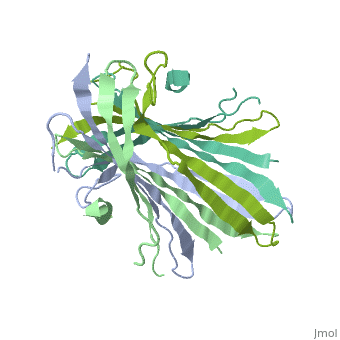Fibroins
From Proteopedia
Fibroins are proteins that constitute silk fibers[1]. Fibroins are large complex proteins and the specific structural details of those making up different types of silk are different, but all fibroins have some common characteristics. See also Fibrous Proteins. Interesting general information on spider silk and a model of one type of a spider silk molecule is at[2]. This model of spider silk shows two repeating domains that all fibroins contain. One domain is characterized as being amorphous, also called flexible, disordered segments, and the other one, symbolized by the boxes, has a highly ordered, repetitive, crystal-like structure. The objective of this exercise is to explicate this ordered domain of fibroins. Repetitive peptide segment & β-sheetDisplayed here is a peptide segment that is present in many fibroin proteins that are found in silk fibers. It is repeated many times to make up the ordered, repetitive structure of the crystalline domain of the fibroin.
A two strand β-sheet is formed by two hexapeptides positioned antiparallel with respect to each other. Show interchain hbonds which hold chains together. Show spacefill display. Adding two more chains to form a four stranded beta-sheet. Show spacefill rendition. Two stacked sheets. The two sheets come together so that the 'Ala side chains' face each other with the methyl and hydroxymethyl groups intercalated. These sheets are attracted to each other and held in place by the hydrophobic forces generated between these side chains. Show interchain hbonds within each sheet. Spacefill display shows that the methyl side chains of the two sheets are close enough to produce hydrophobic forces and that the backbone atoms are close enough to form hbonds. A third sheet is stacked with the other two so that the Gly side chains (hydrogen atoms) intercalate. Show interchain hbonds of all three sheets. Spacefill rendition shows that where the Gly side chains come together the backbonds of the sheets are much closer to each other. Each wireframe chain colored differently. Show spacefill rendition. |
| ||||||||||
3D Structures of fibroin
Updated on 24-May-2018
3ua0 – Fib heavy chain – silkworm
2khm – Fib-3 C-terminal – spider - NMR
2m0m – NaFib-1 residues 250-356 – Nephila antipodiana - NMR
2mqa – NaFib-1 RP domain residues 32-163 - NMR
References
- ↑ Sohn S, Strey HH, Gido SP. Phase behavior and hydration of silk fibroin. Biomacromolecules. 2004 May-Jun;5(3):751-7. PMID:15132657 doi:http://dx.doi.org/10.1021/bm0343693
- ↑ Wikipedia

